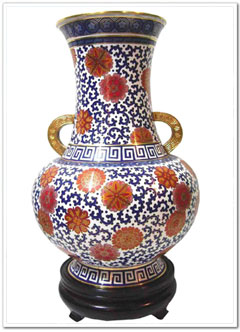 Chinese Cloisonne is the art of applying colored enamels to the surface of a metal object, which is then fired to become a beautiful work of art. Cloisonne originated in Beijing, and the technique reached its perfection as a result of the efforts of Chinese artisans. Chinese Cloisonne is now the standard by which the quality and beauty of Cloisonne is measured worldwide. It ranks as one of China's major contributions to the world's fine arts. The making of Cloisonne is an elaborate and complicated process: base-hammering, copper-strip inlay, soldering, enamel-filling, enamel-firing, polishing and gilding.
Chinese Cloisonne is the art of applying colored enamels to the surface of a metal object, which is then fired to become a beautiful work of art. Cloisonne originated in Beijing, and the technique reached its perfection as a result of the efforts of Chinese artisans. Chinese Cloisonne is now the standard by which the quality and beauty of Cloisonne is measured worldwide. It ranks as one of China's major contributions to the world's fine arts. The making of Cloisonne is an elaborate and complicated process: base-hammering, copper-strip inlay, soldering, enamel-filling, enamel-firing, polishing and gilding.
The earliest extant Cloisonne was made in the Yuan Dynasty (1271-1368) The best was made during the Xuande period (1426-1456) of the Ming Dynasty During the Jingtai period (1426-1456) of the Ming Dynasty, craftsmen developed the beautiful dark-blue enamel which is one of the most popular colors still used today. During the Qianlong period (1736-1795) of the Qing Dynasty the skills of making Chinese Cloisonne reached their pinnacle when pure copper began to be used for the roughcasts.
People enjoy decorating their homes with Chinese Cloisonne articles. Women love Cloisonne bracelets and earrings. Cloisonne articles are often used as gifts. People are attracted by their colorful beauty. In China, most shops in hotels as well as tourist stores sell Cloisonne articles. A variety of items in all shapes and sizes are available, including tables, stools, vases, chopsticks, earrings, candy boxes, toothpicks and smoking tools. They are works of art as well as useful articles.

